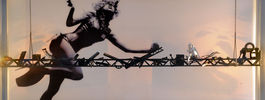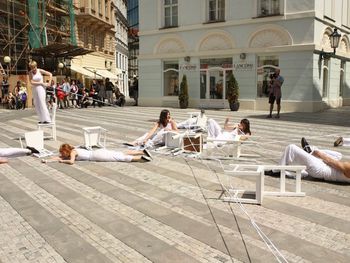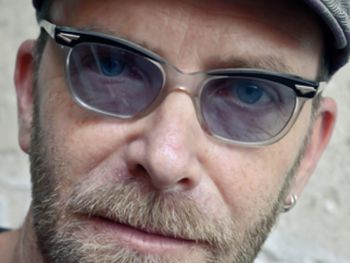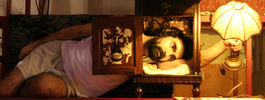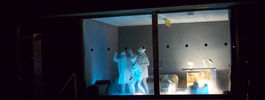

1979 » Hungary » Stage and costume design
| Curator: | József Bögel |
MAĎARSKO
Scenarst of the exhibition: Katalin Teleki Hungarian stage design has in the last fifteen years undergone a substantial development. It has become independent, more ideologically committed and has achieved a significant place in an international context. The determining factor of this development is the flourishing of our cultural life in the broadest sense of the word, as well as our theory. A new generation has come to the forefront, which has at its disposal more modern means of expression and has proved itself capable of providing the Hungarian theatre with new energy. Also the fact that new creative workshops have come into existence should be mentioned. The stage designers of the older generation found themselves faced with new tasks. At the beginning of the sixties the graduates of the Academy of Decorative Arts began to play an important role in Hungarian stage design. They were joined by several specialists in other fields, for instance by engineers and their ranks were further expanded by those who has studied abroad and who contributed to Hungarian theatrical development the experiences and styles of Prague, Leningrad and Bratislava. Now our stage designers are increasingly traveling to foreign countries and also foreign theatrical ensembles come to Hungary and provide us with a concrete notion of the development of stage design throughout the world. The modernization and emancipation of Hungarian stage design is based above all on the intensive work of creative workshops. The number of exhibitions held in the course of the last few years has greatly increased, there 18 an increased interest in stage design theory and a number of monographs and studies have been written which sum up and analyze existing problems. Hungarian stage design has been gaining a good reputation throughout the world, as can be demonstrated on the basis of the medals and prizes gained at the Prague Quadrennial 1975 and at the Triennials at Novi Sad /1966, 1969, 1978/. The development of our stage design had been multifarious. The stage sets designed by Gábor Szinte for the Madách Theatre, by László Drégely for the Comedy Theatre and the Budapest Theatre, as well as the stage designs by Emil Vata for the National Theatre at Pécs have been received exceptionally favorably. The doyen of Hungarian stage designers, Mátyás Varga, has introduced new elements into the techniques he uses - let us cite at least one example - his compositions for the Festival at Szeged. The most important characteristics of the stage sets designed by István Kopeczi Bócze are strong effects combined with a solid mastering of the trade and the capability of expressing an intellectual atmosphere, which sometimes uses symbolism. Varied experiences which are based on combined methods of illumination, projections and the use of stereoscopic effects are coming to the forefront. Arpád Csányi has been getting very good results in this area at the National Theatre, as have Miklós Fehér at the Comedy Theatre and other theatres found in the capital city and outside it and László Székely at the Szigligeti Theatre at Szolnok, which has achieved fame as an excellent creative workshop of drama. György Rajkai, the stage designer at the Thalia Theatre since it was founded, is another very constructive artist and one of the masters of Hungarian stage design, who often uses special lighting effects. Also a number of other artists are seeking methods of achieving special effects. Let us mention in this context Agnes Gyarmathy who in her stage designs has been attempting to conquer theatrical space in a more elementary manner - for instance in her stage designs for the National Theatre at Szeged. The talents of Gyuly Pauer from the theatre at Kaposvár are developing in a similar direction. The best Hungarian stage designers have been successful in overcoming naturalism and the use of details. They sometimes go as far as to essentially recreate theatrical space} these who believe in various modern schools /the simplified theatre, the open theatre, the theatre as a workshop, the theatre as an arena/ have been forming a more pure, elemental space, a sort of arena, in which various concepts can be implemented. This is for instance typical of the work done by Lajos Jánoš, one of the most out - standing members of the middle generation. Due to his unerring modern artistic feeling and his capability of an unusual ordering of theatrical space, he has been successful in designing sets of great expressiveness and rich intellectual content. Ilona Keser, a former painter of oils and frescos, who has become a stage designer deserves special mention. Her designs of sets and costumes have led to the creation of an original picture style which is essentially abstract art, sometimes influenced by cubism, but always closely linked to the content of the play, its situations and characters. Also László Najmányl, who is a former engineer, now works as a stage designer far a number of theatres, both in the capital and in other places. He has been designing original sets which form the illusion of a laboratory, of a theatre rid of all details. Among the youngest generation and among those who studied abroad, some have an inclination towards folklore /Judit Kállai, Sándor Korosi/, while others use original spatial compositions and use unusual materials /Judit Zimmer/. The set designers of Hungarian Television, who often collaborate with various theatres, also belong to the dynamic trend in our stage designing. Let us mention Robert Wegenast who has designed sets full of poetry, Gábor Balló, Barna Tóth, Judit Szekulesz, Sándor Nagy and Sándor Lévai. Costume designers have come to play a foremost role in Hungarian stage design. In this area one can speak of a ''Hungarian school which is headed by the costume designer of the National Theatre, Judit Schaffer /who is also an outstanding professor/. Her numerous designs for the theatre and for Hungarian films are specific and elegant, they express a certitude of taste, a commitment to ideas and a force of expression. Her costumes designed for Layos Maróti's play The Night Before Last, played at the National Theatre, received a Silver Medal at the last Prague Quadrennial. J. Schaffer, as well as other costume designers - Marianne Wieber, who works for télévision, as well as theatre, Nelli Vágó from the National Theatre and Marta Jánoskuti from the Comedy Theatre - all design so-called "dynamic costumes. Each of them has her own personal style and uses original means /they differ in their choice of materials and the way they are used/, but their costumes provide various possibilities of multiple combinations and this stresses their dynamism. The costumes designed by Erzsébet Mialkovszky are also very original. A very special place belongs to Hungarian puppet makers who are well-known throughout the world. Let us name above all Ivan Kóos and Vera Brody and their inimitable work at the Budapest Puppet Theatre which has breathed life into the magical world of fairy tales for children, as well as the modern and classical drama and opera. As far as lyrical theatre is concerned, it also deserves a special chapter we must, however, limit ourselves to name only three artists who all work both for lyrical theatres and for others. They are Tivadar Márk, the creator of beautiful expressive costumes, Gábor Forray, for whom perfect taste and a high commitment to ideas are typical and finally Peter Makal, the tireless seeker of new means of expression. In view of all that has already been done, we can in conclusion and full justification say that Hungarian stage designs are constantly developing and advancing.
